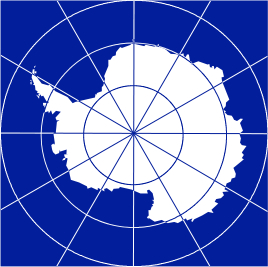I mentioned in yesterday’s journal that while sitting in Poland’s Arctowski Station on King George Island, I thought a great deal about the Antarctic Treaty. The treaty states that Antarctica is to be used for peaceful purposes only and that no nation can establish military bases or test weapons there. Scientists who do research in Antarctica are, in some ways, diplomats.

Antarctica is different from the other continents in many ways: it has never seen war, it has no native people and no countries. Nobody really lives in Antarctica; everyone is a visitor. There have been disputes over ownership of islands in the Southern Ocean and parts of Antarctica itself, dating back to explorers who lived during the 1600’s. Since then, a great deal of posturing has taken place by different nations vying for a piece of the continent.
Following World War I, Great Britain and France claimed large pie-shaped areas of Antarctica that met at the South Pole and in 1938, Hitler sent seaplanes to Antarctica to stake a claim for Germany. The planes dropped 5-foot long, aluminum darts topped with swastikas in an area covering 96,500 square miles. This action prompted Norway to stake a claim. In 1939, American Richard Byrd led the first U.S. government expedition to Antarctica in 100 years and the U.S. State Department recommended that the U.S. claim land explored by Byrd in addition to a large part of the Peninsula. Although the claim was never officially made, the possibility prompted Chile to stake a claim in 1940, including a pie-shaped area that included the Peninsula and overlapped with half of the British claim. In 1943, Argentina made a claim for another pie-shaped area overlapping much of the British and Chilean claims.
By the 1950’s, the U.S. had explored more of the continent than all other countries put together, but was still not officially making any claims. Despite tensions between the U.S. and the Soviet Union during the Cold War, the countries cooperated in Antarctica during the International Geophysical Year (IGY) in 1957-1958. The IGY is another very interesting piece of Antarctica’s history. Scientists from the International Council of Scientific Unions proposed 18 months of intense observations of the earth from July 1957 to December 1958. This time period was chosen because the sun was at the peak of its 11-year cycle. Auroras were occurring frequently at this time, creating a nice backdrop for the project; all of the earth was being studied during the IGY, with the earth’s polar regions as a focus.
During the planning phases for the IGY between 1955 and 1957, the U.S. built the South Pole Station and began turning McMurdo Station into today’s largest Antarctic research base. In 1958, American President Dwight Eisenhower invited nations having IGY stations of their own and/or claims in Antarctica to negotiate the future of the continent. These nations included: Argentina, Australia, Belgium, Chile, France, Japan, New Zealand, Norway, South Africa, the Soviet Union and the United Kingdom. By 1961, all twelve nations ratified the Antarctic Treaty.
The treaty has now been ratified by more than 40 nations; all are performing scientific research in Antarctica. These nations meet annually to discuss additions or changes to the treaty. All must agree before changes to the treaty are made. Countries include:
- Argentina
- Australia
- Austria
- Belarus
- Belgium
- Brazil
- Bulgaria
- Canada
- Chile
- China
- Colombia
- Cuba
- Czech Republic
- Denmark
- Ecuador
- Estonia
- Finland
- France
- Germany
- Greece
- Guatemala
- Hungary
- India
- Italy
- Japan
- Malaysia
- Monaco
- Netherlands
- New Zealand
- North Korea
- Norway
- Papua New Guinea
- Peru
- Poland
- Portugal
- Romania
- Russia
- Slovakia
- South Africa
- South Korea
- Spain
- Sweden
- Switzerland
- Turkey
- Ukraine
- United Kingdom
- United States
- Uruguay
- Venezuela
In 1970, President Richard M. Nixon stated U.S. policy for Antarctica to be:
To maintain the Antarctic Treaty and ensure that this continent will continue to be used only for peaceful purposes and shall not become an area or object of international discord.
To foster cooperative scientific research for the solution of worldwide and regional problems, including environmental monitoring and prediction and assessment of resources.
To protect the Antarctic environment and develop appropriate measures to ensure the equitable and wise use of living and nonliving resources.
Nixon added, “Science has provided a successful basis for international accord, and the Antarctic is the only continent where science serves as the principal expression of national policy and interest.” Just one more reason to love the place…


Comments